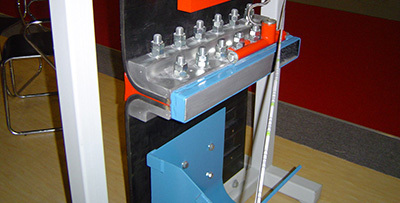News Center
Hezi technology focuses on the research and development of "rapid seamless conveyor belt joint sleeve" innovative technology project

NEWS CENTER

News Details
Understanding the Role of Conveyor Rubber Belt Fasteners in Industrial Applications
Release time:
2025-08-10
Understanding the Role of Conveyor Rubber Belt Fasteners in Industrial Applications Table of Contents 1. Introduction to Conveyor Rubber Belt Fasteners 2. Importance of Conveyor Rubber Belt Fasteners in Industrial Settings 3. Types of Conveyor Rubber Belt Fasteners 3.1 Mechanical Fasteners 3.2 Bonded Fasteners 3.3 Specialty Fasteners 4. Application Areas of Con
Understanding the Role of Conveyor Rubber Belt Fasteners in Industrial Applications
Table of Contents
- 1. Introduction to Conveyor Rubber Belt Fasteners
- 2. Importance of Conveyor Rubber Belt Fasteners in Industrial Settings
- 3. Types of Conveyor Rubber Belt Fasteners
- 4. Application Areas of Conveyor Rubber Belt Fasteners
- 5. Installation Process of Conveyor Rubber Belt Fasteners
- 6. Maintenance and Care for Conveyor Rubber Belt Fasteners
- 7. Benefits of Using High-Quality Conveyor Rubber Belt Fasteners
- 8. Conclusion
- 9. FAQs
1. Introduction to Conveyor Rubber Belt Fasteners
In the realm of industrial applications, **conveyor systems** form the backbone of material handling processes. These systems rely heavily on **rubber belt fasteners** to ensure efficient operation. Conveyor rubber belt fasteners play a pivotal role in connecting the lengths of conveyor belts, providing the necessary tension and flexibility for smooth operation. Understanding their importance and functionality is essential for anyone involved in industrial operations.
2. Importance of Conveyor Rubber Belt Fasteners in Industrial Settings
The significance of conveyor rubber belt fasteners extends beyond mere connection. They ensure that belts operate effectively without slippage or misalignment, which can lead to costly downtime. Fasteners enhance the overall **operational efficiency** of conveyor systems, enabling industries to meet production demands swiftly. Additionally, utilizing the right fasteners contributes to the **safety** of the workplace by reducing the risk of accidents due to malfunctioning equipment.
3. Types of Conveyor Rubber Belt Fasteners
Understanding the different types of conveyor rubber belt fasteners is crucial for selecting the right one for your industrial application. Each type offers unique benefits and is suited for specific operating environments.
3.1 Mechanical Fasteners
Mechanical fasteners are designed for easy installation and removal. Common varieties include **plates, clips, and lacing systems**. These fasteners allow for quick repairs and replacements, minimizing downtime. Mechanical fasteners are typically made from durable materials such as steel or composite materials to withstand harsh operating conditions.
3.2 Bonded Fasteners
Bonded fasteners utilize adhesive materials to create a permanent connection between the belt ends. This type of fastener is particularly beneficial for applications that require a smooth surface for material flow. Bonded fasteners are less prone to snagging or catching, making them ideal for environments where product integrity is crucial.
3.3 Specialty Fasteners
For unique applications, specialty fasteners are available. These may include fasteners designed for specific belt materials or tasks such as high-temperature resistance or chemical exposure. Understanding the unique requirements of your operation will aid in selecting the most appropriate specialty fasteners.
4. Application Areas of Conveyor Rubber Belt Fasteners
Conveyor rubber belt fasteners are used across various industries, including mining, manufacturing, food processing, and logistics. Each industry has specific requirements that determine the type of fasteners needed.
Mining and Aggregate Industries
In mining, conveyor belts transport heavy materials over long distances. The robust construction of mechanical fasteners makes them suitable for this sector. They can handle heavy loads and are less likely to fail under extreme conditions.
Manufacturing and Assembly Lines
In manufacturing, where precision is critical, bonded fasteners are often favored due to their seamless connections. A smooth belt surface ensures that products move without disruption, optimizing the assembly process.
Food Processing and Packaging
In food processing, hygiene and safety are paramount. Specialty fasteners designed to resist moisture and bacteria growth are essential. These fasteners ensure that the belts can be cleaned thoroughly, maintaining sanitary conditions.
Logistics and Distribution Centers
In logistics, speed is essential. Conveyor systems that utilize mechanical fasteners allow for quick adjustments and repairs, ensuring minimal downtime and efficient operations.
5. Installation Process of Conveyor Rubber Belt Fasteners
The installation process of conveyor rubber belt fasteners can vary depending on the type of fastener used. Below is a general guide to installing mechanical and bonded fasteners.
Installation of Mechanical Fasteners
1. **Preparation**: Ensure both ends of the conveyor belt are clean and free of debris.
2. **Alignment**: Position the belt ends together, ensuring they are aligned correctly.
3. **Installation**: Attach the fastener plates or clips as per the manufacturer’s instructions.
4. **Testing**: Once installed, run the conveyor to ensure that the fasteners hold firmly and the belt operates smoothly.
Installation of Bonded Fasteners
1. **Surface Preparation**: Clean the surfaces thoroughly to ensure a strong bond.
2. **Adhesive Application**: Apply the adhesive as recommended by the manufacturer.
3. **Pressing**: Align the belt ends and press them together, ensuring even pressure is applied.
4. **Curing**: Allow the adhesive to cure fully before running the conveyor to avoid premature failure.
6. Maintenance and Care for Conveyor Rubber Belt Fasteners
Regular maintenance is essential for ensuring the longevity and reliability of conveyor rubber belt fasteners. Below are key maintenance practices:
Regular Inspections
Conducting routine inspections will help identify any wear or deterioration in fasteners. Look for signs of rust, wear, or loose connections.
Cleaning
Keeping the belts and fasteners clean is crucial, especially in food processing environments. Regular cleaning minimizes contamination risks and ensures efficient operation.
Replacement
Do not hesitate to replace worn or damaged fasteners promptly. Early replacement can prevent further damage to the conveyor system and avoid costly downtime.
7. Benefits of Using High-Quality Conveyor Rubber Belt Fasteners
Investing in high-quality conveyor rubber belt fasteners offers numerous advantages, including:
Increased Efficiency
Quality fasteners provide reliable connections that enhance the overall efficiency of conveyor systems. They reduce the risk of slippage, ensuring materials move smoothly.
Cost-Effectiveness
While high-quality fasteners may have a higher initial cost, their durability and reliability lead to lower maintenance costs in the long run.
Enhanced Safety
Using robust and reliable fasteners minimizes the risk of equipment failure, thereby enhancing workplace safety.
8. Conclusion
Conveyor rubber belt fasteners are essential components that ensure the efficiency and reliability of industrial conveyor systems. Understanding the various types of fasteners, their applications, and the importance of proper installation and maintenance is crucial for optimizing industrial processes. By investing in quality fasteners, industries can enhance operational efficiency, reduce downtime, and improve workplace safety.
9. FAQs
What are the most common types of conveyor rubber belt fasteners?
The most common types include mechanical fasteners, bonded fasteners, and specialty fasteners, each suited for different applications and environments.
How do I know which fastener to choose for my application?
Consider factors such as the type of materials being transported, operating conditions, and whether quick repair is necessary when selecting a fastener.
How often should I inspect conveyor rubber belt fasteners?
Regular inspections should be conducted at least once a month or more frequently in high-usage environments to ensure optimal performance.
Can I install conveyor rubber belt fasteners myself?
Yes, many mechanical fasteners are designed for easy installation. However, bonded fasteners might require more detailed procedures, so follow manufacturer guidelines carefully.
What maintenance is required for conveyor rubber belt fasteners?
Regular inspections, cleaning, and timely replacement of worn fasteners are essential for maintaining the performance of your conveyor system.
Next Page

Recommend News





























